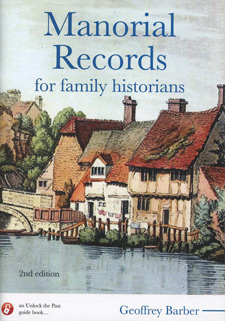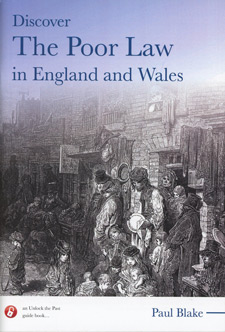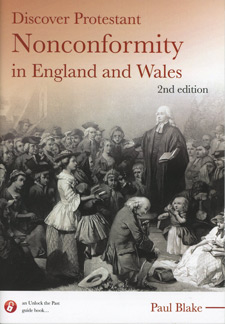The following guides are new to the USA, and new in their own right, being previously printed in 2018 in Australia. FRPC recently received the rights to publish them in the USA, allowing the books to be marketed to genealogists in America at a great savings. These are excellent guides, and we’re excited about being able to share them with our readers.
The three volumes are:
- Manorial Records for family historians – by Geoffrey Barber
- Discover the Poor Law in England and Wales – by Paul Blake
- Discover Protestant NonConformity in England and Wales – 2nd Edition – by Paul Blake
Following are details about each individual book:
Manorial Records for Family Historians, 2nd ed.; by Geoffrey Barber; 2018; 88 pp; 5.75×8.25; b&w & color photos, glossary, further reading, index, paperback; ISBN: 9781925781649; Item #: RUTP0131
Reg. $15.95 – Just $13.56 on the website during the sale.
The manorial system, introduced to England and Wales by the Normans, lasted until 1926 and the surviving records can provide wonderful insights into the personal lives of our ancestors.
Henry Chandler wrote in 1885 that manorial records ‘enable us to drop down suddenly on an obscure English village five hundred years ago, and almost to see with our own eyes what the inhabitants are doing’.
However, it seems that few genealogists understand manorial records, and how the manor operated. The aim of this book is to cut through a complex mix of social and legal history to give family historians the knowledge and confidence to start utilizing these records. Once understood, the rewards are immense.
The book also contains many examples of how records from the manors of Rotherfield in East Sussex and Datchurst (alias Hildenborough) in Kent were used by the author in how own research.
Contents:
- Introduction
- Access to manorial records
- The origins of the manor
- The manor: an overview
- Social structure on manorial estates
- Freemen (free tenants)
- Villeins (unfree tenants)
- Administration of the manor
- Land tenure
- Demesne land
- Copyhold or Customary tenure
- Freehold land
- Leasehold land
- Manorial courts
- Court Leet
- Court Baron
- A description of the Manor of Rotherfield, Sussex in 1400
- Locating property using manorial records
- Example 1. Widow Barber’s Cottage
- Example 2. Drapers
- Example 3. Bonnetts
- Conclusion
- Glossary
- Further reading
- Appendix: The Feudal system and the history of wills
- Index
Purchase the book at the FRPC website.
__________
Discover the Poor Law in England and Wales; by Paul Blake; 2018; 64 pp; 5.75×8.25; b&w photos, timeline, bibliog, addresses, index; paperback; ISBN: 9781925781380; Item #: RUTP0342
Reg. $12.95 – Just $11.01 on the website during the sale.
The Poor Law has an extreme impact on English and Welsh society from the sixteenth century, right through to the twentieth. It played a central role in the country’s social and political development from the Reformation to the Industrial Revolution, and beyond. Initially, the regulations were designed to reform the poor as much as to relieve poverty.
The Poor Laws touched nearly every aspect of the lives of many families over five centuries: those who found it necessary to seek help in their hours of need, as well as those who organized and paid for the relief that the deserving poor sought and were entitled.
Necessarily, the Poor Laws produced a wealth of documentation referring to individuals and families across the country. Survival of the records varies from parish to parish, town to town, and from 1834, Poor Law Union to Poor Law Union. However, when and where the records do survive, then they can be a goldmine of information and a major source for family historians.
The evidence they contain can solve many problems, particularly of migration and family relationships. But, perhaps most importantly, they can provide a rare insight into our ancestors’ lives.
Contents:
- Introduction
- Sixteenth century – Charity
- Charity
- The Elizabethan Poor Laws
- 1597/8 Poor Law Act
- 1601 Poor Law Act
- Workhouse Test Act
- Assessments
- The Poor Laws 1750-1834
- Gilbert’s Act
- Speenhamland System
- Settlement and Removal
- Settlement
- Removal
- Illegitimacy
- Apprenticeship
- The New Poor Law
- Poor Law Unions
- Workhouses
- Admission and Discharge Registers
- Creed Registers
- The Workhouse Website
- Poor Law Union Correspondence
- Poor Law Emigration
- The Final Years
- Records
- Local Holdings
- Transcripts and Indexes
- Commercial Websites
- Newspapers
- Conclusion
- Timeline
- Bibliography
- Addresses and Contact Details
- Websites
- Museums
- Record Offices and Libraries
- Index
Purchase the book at the FRPC website
__________
Discover Protestant Nonconformity in England and Wales, 2nd ed.; by Paul Blake; 2018; 60 pp; 5.75×8.25; b&w photos, timeline, bibliog, addresses, index; paperback; ISBN: 9781925781007; Item #: RUTP0341
Reg. $12.95 – Just $11.01 on the website during the sale.
The aim of this book is to introduce researchers to Protestant nonconformity in England and Wales – whether they’re family or local historians, or others who have a general interest in the subject.
Not all our ancestors were Church of England, or even Catholic. A fair number, particularly after the start of the eighteenth century, joined other denominations such as Baptists, Congregationalists or Methodists. Although the State at various periods did its best to eradicate Catholicism and all forms of Protestant nonconformity, particularly during the late-sixteenth and seventeenth centuries, large numbers persisted in their thinking and were persecuted for their beliefs.
Therefore, it is quite usual, almost expected, for those researching their family in England and Wales to find it includes religious dissenters. Identifying these folk is not always straightforward: they may have continued to use the local parish church for their baptisms, marriages and burials; and may have belonged to congregations that kept few (if any) records. But there are often clues. Their beliefs, at variance to those of the Anglican Church, may have been short-lived or they may have lasted through many generations and perhaps still persist today.
As more and more records relating to protestant nonconformists become available online, the task in discovering more about them is becoming easier. And that trend is sure to continue.
Contents:
- Introduction
- 1. Overview
- 2. Church and State
- 3. The Penal Laws
- 4. Ecclesiastical Visitation Returns
- 5. Recusant Rolls
- 6. Protestation Returns
- 7. Many Sects
- 8. The Commonwealth and Protectorate
- Loyalist Composition Papers
- 9. 1662 Act of Uniformity
- 10. Return of Papists
- 11. Compton’s Census
- 12.. Meeting House Certificates
- 13. Nonconformist Registers
- Hardwicke’s Marriage Act
- 14, Registries of Births
- Dr Williams’s Registry
- Dr Williams’s Library
- Wesleyan Metropolitan Registry
- 15. Burials
- Bunhill Fields
- Gibraltar Row, Bethnal Green
- 16. Deposited Registers
- Other non-deposited registers
- 17. Online resources
- FamilySearch
- TheGenealogist
- Ancestry
- Findmypast
- Deceased Online
- 18. Scotland and Ireland
- Scotland
- Ireland
- Findmypast
- Timeline
- Bibliography
- Addresses and contact details
- Index


